Are you looking for ways to take your digital marketing strategy to the next level in 2024? Finding the correct methods and techniques of “how to do Competitor analysis” can be an excellent tool for gaining insight into what strategies your competitors are using and how successful they’re so that you can use that data to improve your initiatives.
This comprehensive guide will explain how to effectively analyze your competitors’ online presence, identify trends, and develop a tailored SEO strategy for success. Through the creative use of analytics tools, keyword research, content marketing tactics, and other methods, this article discusses what will help you keep ahead of the curve by analyzing what works well.
This article is going to be a little longer for you to read because, in this blog post, we’re going to break down everything you need to know about competitor analysis: from why it matters and which methods or techniques work best up to actionable steps that will help boost your SEO results. So, let’s get started!
Table of Contents
ToggleWhat is the Competitor Analysis Process?
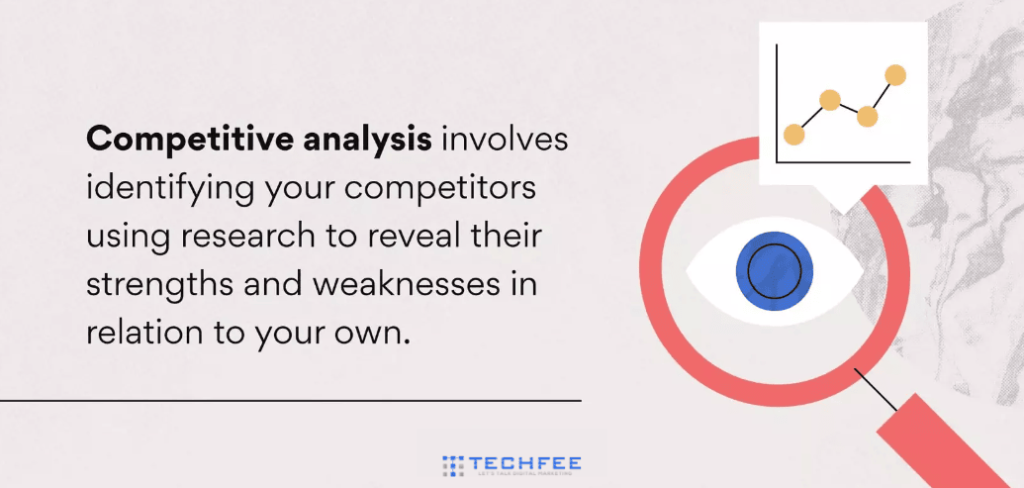
Competitor analysis in marketing continuously examines how competing businesses work to inform and improve your business strategies. This includes researching prospective competitors, analyzing their products and services, investigating customer service and pricing strategies, studying market conditions, and tracking their activities, among other tactics, and understanding platforms for engagement, social media presence, and marketing efforts.
By being aware of your competition, you can accurately assess what it’ll take to stay ahead of them. Competitive analysis can identify gaps in the market or areas where you can establish a presence or reignite focus within your current industry space. In addition, you can gain invaluable insights into target customer interests, behaviors, and motivations through competitive analysis in business to help you decide on marketing campaigns or product offerings.
Analyzing competitors also allows an enterprise to see what competition is doing, capitalize on opportunities in the market, identify trends from data-based approaches, take corrective actions in response to actions taken by competition, evaluate different market positions, and increase organizational agility.
What is The Objective of Competitor Analysis?
Competitor analysis is a crucial factor in business strategy development, as it provides an understanding of the industry landscape by taking into account the tactics and strategies of current or potential competitors. The primary purpose of competitor analysis is to uncover unique insights that help identify competitive advantages and inform product design, resource allocation, marketing, and positioning tactics.
It also helps businesses stay one step ahead by developing countermeasures to counter potential competitive moves. By assessing potential weaknesses and strengths among current and future competitors, companies can develop strategies to gain market share more quickly.
This allows them to focus their resources on those areas where their strengths are greatest – leading to improved profitability. Moreover, business competitor analysis informs pricing strategies so companies can remain price-competitive.
Why Competitor Analysis is Important For SEO?
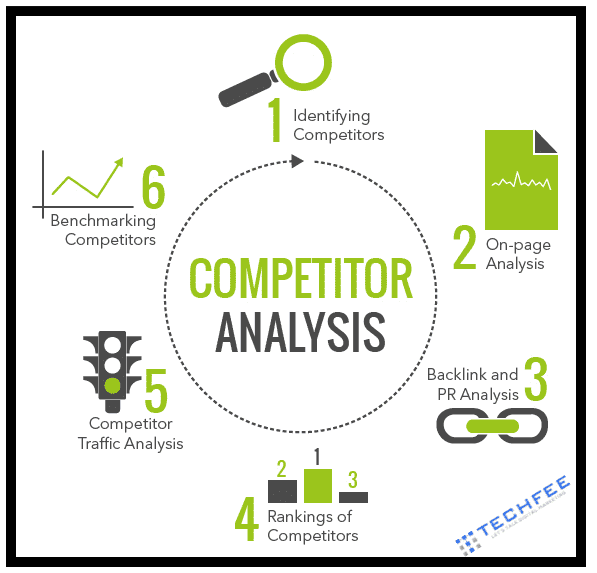
Competitor analysis is incredibly important for SEO success, as it helps to determine how to optimize a website and increase visibility online. In addition, it allows us to benchmark our efforts against our competitors, analyze their best strategies, and assess the areas in which we must improve.
Through competitor analysis in the business plan, we can discover what is working for them and refine our SEO efforts accordingly; by duplicating successful strategies from other websites, you can achieve similar results for your online presence.
In this way, you can build a compelling competitive advantage over your peers for higher rankings on search engine result pages. Ultimately, competitor analysis enables SEO professionals to identify potential opportunities more quickly, so they can focus on actions that will make the most impact.
KPI for Competitor Analysis
KPI for competitor analysis is a great way to measure a company’s competitor’s success within the same marketplace. This assessment measures important metrics such as product performance, customer reviews, marketing resources available, and cost savings.
It helps managers analyze the competitive landscape and identify areas of opportunity or weak points that need improvement. In addition, companies can track the impact of their decisions by using KPIs for competitor analysis to ensure that their strategies remain on track and that over-performance or under-performance can be adjusted accordingly.
KPI for competitor analysis is essential for businesses looking to gain an edge in the marketplace. By better understanding the current competitive environment, companies can make informed decisions to stay ahead of their competitors in the market.
Types of Competitors
Every business should be aware of competitors they may face in the marketplace. While competition can bring out the best in a business and help drive innovation, understanding who your competitors are is essential in staying competitive.
There are three types of competitors: direct, indirect, and substitute. Direct competitors offer products or services similar to what your business provides, while indirect competitors offer complementary products or services within the same space.
Finally, substitute competitors are those that offer something different altogether but which satisfy the same customer need. Knowing your types of competitors is an essential part of designing a comprehensive marketing strategy and will ultimately set every business up for success.
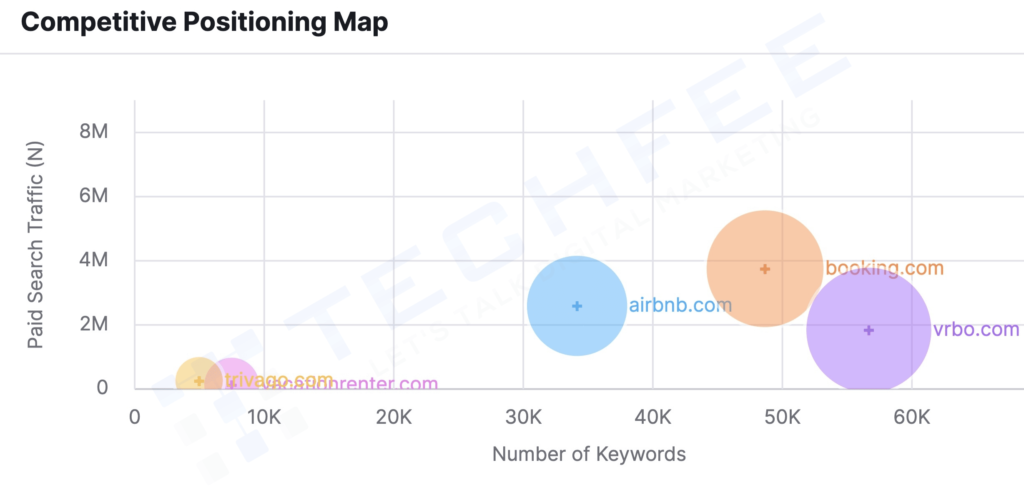
Benefits of Competitor Analysis
Performing competitor analysis can deliver significant benefits for businesses of any size. This proactive approach to market intelligence helps establish realistic objectives and validates strategies. In addition, an up-to-date understanding of the competition allows companies to identify opportunities to differentiate their products or services, understand industry trends, spot new threats, target resources effectively, and find inspiration for innovation.
Lastly, competitor analysis results are essential for creating effective pricing strategies that balance the total market to maximize returns. Investing in competitor analysis delivers insights and strengthens overall performance in the long run.
How to Do Competitor Analysis Step by Step
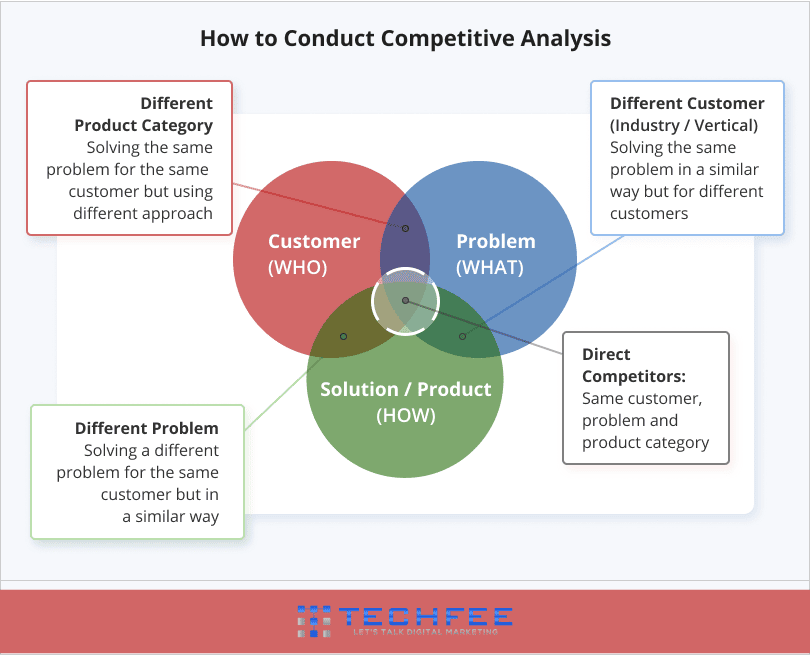
Regarding competitor analysis, the process can seem daunting – How do you study what your competitors are doing? How do you make sure you have the latest and most accurate information? Fear not! Doing competitor analysis is relatively straightforward.
Start by researching both online (social media accounts and websites) as well as offline (events, conferences, etc.) so that you can keep track of changes your competitors may be making. Pay attention to things like pricing and messaging. Then, use data from your website analytics to measure how people interact with your site versus a competitor’s site.
Are they staying longer? How many pages do they visit? Regularly monitor these numbers to ensure you know where betterment is needed. Following these steps and implementing competitor analysis into your business plan is an excellent way to stay ahead!
1. Identify Your Competitors
- Who are your direct competitors?
Identifying competitors is a critical component of any business competition analysis. Knowing who your direct competitors are essential since this can help you understand the market better and give you valuable insight into what strategies may or may not work for your business.
Identifying your direct competitors can be done by researching the marketplace and understanding which companies sell similar products or services. Look at their search engine rankings, number of customers, and reviews, and evaluate the strengths and weaknesses of their products or services relative to yours.
With this knowledge, you will be better equipped to build on your competition’s successes while taking advantage of any opportunities to differentiate yourself from them. In addition, identifying your main competitors will provide you with crucial information needed to make more informed decisions about your business and enable you to plan competitive strategies.
- Who are your indirect competitors?
Identifying your competitors is the first step in practical competitive analysis. However, it’s essential to not just look at your direct competitor’s information but also to think beyond and consider who may be an indirect competitor too.
Indirect competitors include businesses offering alternative products or services to meet the same need or appeal to the same market. Identifying these indirect competitors can give you a clearer picture of the competitive landscape and enable you to take a more informed approach when investing in marketing, advertising, product development, and pricing.
- Tools to help you identify your competitors
Luckily, many competitor analysis tools are available, like website traffic analysis, how to do keyword research and technical analysis tools that can help you identify who your competitors are and understand what they’re doing.
In this article, I will name all those tools that offer insight into industry trends and levels of engagement with different competitors. So whether you prefer a comprehensive platform or something more straightforward with a single focus, explore the options available and find the best fit for your needs.
2: Analyze Their Website And Online Presence
- Website design and user experience
Analyzing your competitor’s website and online presence is a great way to get an idea of what they’re up to – and how you can stand out from the pack. Investigate the website design, user experience, and general functionality of their online setup. Take note if some elements or features differentiate them from others in the same industry, as this information can be valuable for setting your strategy for success.
Analyzing their online presence gives you insight into their strategies and an understanding of how consumers interact with them; remember these observations when formulating your marketing plans.
- Content strategy and keywords
Monitoring the trends of their content strategy and associated keywords gives valuable information about how to approach your marketing strategies for optimal success. I use the Ubersuggest tool to find competitors’ ranking keywords and to know the position of the online presence of a website or blog with that particular keyword.
Additionally, keep an eye out for any gaps in their plan that can indicate opportunities for creating services or products that could set you apart. Analyzing your competitors requires time and effort, but it can pay big dividends regarding insight into what works best within the market you choose to do business in.
Remember — learning from our competition makes us all better!
- Backlink profile and domain authority
Analyze their ranking positions and click-through rates on search engines to gain insight into how well they’re performing compared to you. You can then look at their backlink profile and domain authority, which will give you insight into where their strength lies online.
Analyzing these areas will help you identify where they’re targeting their efforts and where they may need to catch up. With this information, you can plan tactics to take your business to the next level.
- Social media presence and engagement
Analyzing social media competitor analysis and their engagement could be ideal for understanding their target users and what platforms they use to reach them. Additionally, keeping an eye on their social media channels can be helpful to gauge what type of engagement they’re getting with their audiences and any changes they may be seeing in the industry due to their presence.
Social media brand analytics will give you an advantage when creating effective strategies. By keeping track of all this information, you can make informed decisions when conducting competitor analysis and gain an edge over them in the market.
3: Analyze Their SEO Strategy
- Target keywords and search engine ranking positions
Target keywords and search engine ranking positions are essential when looking at how well your competitors are doing compared to yourself.
Analyzing their SEO strategy will help you better understand what works for them. Then, you can take away that knowledge and use it for your search engine optimization endeavors.
- On-page optimization tactics
On-page SEO optimization tactics and strategies are all the elements of a site’s pages that can impact its ranking, such as keyword usage, loading speed, quality of content, and engagement metrics like time on page and bounce rate. Analyzing each tactic helps inform what your SEO strategy should look like.
- Off-page optimization tactics
Doing competitor analysis is an integral part of informing your SEO strategy. To ensure you have the advantage over the competition, look at how they handle their SEO and off-page optimization.
In addition, consider their content quality and marketing strategies from an outsider’s perspective.
Uncover any weak areas in their tactics to increase your efforts. Analyze the keywords, backlinks, social media influence, and other elements associated with their off-page optimization tactics to pinpoint where you can differentiate yourself for tremendous success.
- Content marketing and link-building strategies
Content marketing involves creating engaging and helpful content specific to what you are trying to convey. At the same time, link-building is optimizing links that lead to your website from outside sources.
Analyzing a competitor’s SEO strategy allows you to understand how they approach various ranking factors and may inspire you with fresh ideas for solutions for your own business.
In addition, researching their methods and understanding what works for other companies in your industry can help establish a more comprehensive view when crafting your successful SEO strategy.
4: Use the Insights to Improve Your SEO Strategy
- How to incorporate the insights from your competitor analysis into your strategy
The key to success in the modern business world is to know your competitors’ strategies and stay one step ahead. But simply understanding your opponents’ strategies is not enough – you must also be able to incorporate the insights from your competitor’s analysis into your strategy.
The best way to do this is first to analyze how well their moves are working by analyzing the success of their campaigns and products. Then, by understanding the pros and cons of these initiatives, you can apply these learnings to take advantage of gaps that exist in the market or improve upon existing solutions.
Using a competitor analysis will help give you an edge when making decisions on product development, marketing campaigns, and pricing. Whether looking at industry benchmarks or examining market trends, an effective competitor review will be invaluable in building a successful strategy.
- Implementing the tactics and strategies that your competitors are using successfully
Take note of successful campaigns that your competitors are running or doing well. Examine how they engage their target audience with compelling content or consider how they leverage technology to stay ahead of the game. Implementing the most successful strategies could help propel your business further than ever before.
- Innovating and finding ways to differentiate your strategy from your competitors
Innovating and differentiating your strategy from competitors can significantly increase business success. Therefore, looking at all the different opportunities that could help your product or service stand out is crucial.
Whether it’s looking into different marketing strategies, approaches to pricing, production techniques, or customer experience, these innovative initiatives can give you an edge over competitors.
Innovative ideas can come from other industries, too – think outside of the box and keep up with trends in adjacent markets that could give you the right inspiration. Taking the time to research the competition and what others are doing in terms of innovation and finding ways to differentiate your ideas and strategies is essential for any organization hoping for long-term success.
5: Analyze Your Cmpetitors' Strengths And Weaknesses
Analyzing the strengths and weaknesses of your competitors is an essential part of successful competitor analysis. Analyzing your competitors’ current performance, objectives, resources, strategies, and positioning in the market can give you insight into their chances of success and offer important information about who they are and what they do.
A thorough evaluation enables you to identify gaps in their offerings that you can use to differentiate yourself from them or capitalize on their mistakes to gain an edge over them.
Moreover, a deep dive into their activities allows you to analyze their existing strategies’ effectiveness and helps guide where you should focus on yours. Finally, competitor analysis can help you understand and monitor your competitors and sharpen your strategy.
6: Compare Product Features
When comparing product features, there are a few key things to remember. First, you want to ensure that you’re looking at similar products in terms of size, price, and target audience.
Secondly, you’ll want to consider the features of each product and how they stack up against one another. Finally, you’ll want to consider your needs and priorities when choosing a product. By considering all these factors, you can do competitor product analysis effectively.
7: Check Online Reviews
If you own a business, staying current on what your competitors are doing is essential. Check their online reviews and ratings regularly for a complete picture of the market landscape. Doing this type of competitor analysis gives you a better idea of how they are performing, what questions consumers may have about them, and how their customers feel after working with them.
This data can be precious in helping you improve your products and services to stand out from the competition!
8: Talk to Competitors' Customers
Taking the time to talk to customers is one of the best competitor analysis methods to gain valuable insights into how your competition works and what strategies might be most effective. By engaging in conversations with their customers, you can better understand their unique value proposition, their strengths and weaknesses, and what approaches they take to increase their customer base.
While competitor analysis can take many forms, talking directly with customers gives you an in-depth perspective on the market and how it works, which could help inform your strategies. Whether you’re new to this type of research or you want to refine your approach, taking the time to Talk to competitors’ customers is a great way to get ahead of the game.
9: Create a Competitor Matrix
Before considering your competitor analysis framework, take the time to get organized. Then, utilize a helpful tool like a competitor matrix or competitive analysis grid, making it easier to compare findings and spot trends across competitors.
Designate one row or column for each identified rival; list data points you’d like to discover about each company on the other axis – feel free to modify this as necessary throughout your research!
10: Use Research Tools
Whether you are a business starting or an established organization, staying informed on what your competitors are up to is essential. Use research tools to do a comprehensive competitor analysis and gain valuable competitive analysis report into practical strategies that have worked for them and areas of opportunity for you.
Such information can be vital in differentiating yourself from the competition and staying ahead in today’s ever-changing market.
11: Use a SWOT Analysis
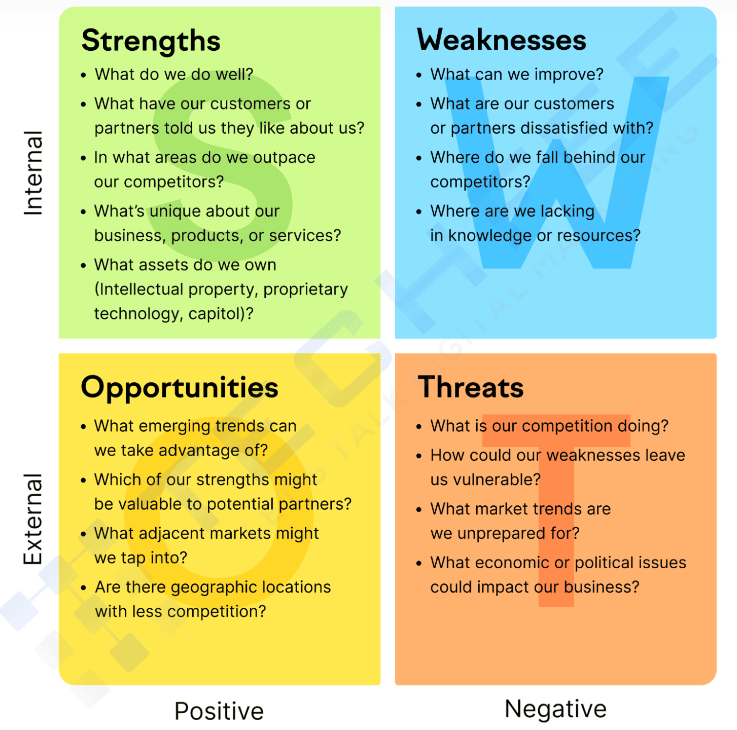
A SWOT analysis is a valuable tool to conduct a competitor analysis and gain insight into the strengths and weaknesses of your organization compared to other competitors. Use this powerful competitive analysis model to assess the Strengths, Weaknesses, Opportunities, and Threats of your business.
Analyzing these aspects of each competitor can help you identify who is performing well in the market and what they are doing differently that makes them successful.
The SWOT analysis can enable you to compare yourself better against others in the same industry to make informed decisions about creating sustainable growth for your firm. Use this approach wisely — it may give you the edge you need to understand better what sets you apart from your competitors.
12: Gather Background Information
- Company History
Get the complete picture by exploring their “About” section online and reading through any past press releases. You’ll find sought-after details such as initial funding sources, mergers & acquisitions, and founding dates – essential pieces of knowledge to put you ahead of the competition!
- Location
Knowing the base and reach of your competition is a must for any business. For e-commerce, you might be up against companies selling their products worldwide! Meanwhile, if your shop has physical premises, it’s sure to have competitors in its backyard. Keeping an eye on who they are and where they’re located can give you great insights into how best to stay ahead of them.
- Company size
LinkedIn and Glassdoor can help you uncover the number of people they employ. It’s also helpful to investigate their customer base and any estimated financials online for larger companies. More granular data might be harder to come across if they’re privately held businesses, but it doesn’t hurt to take a look!
13: Focus on the 4 P's
- Product
Get to know what’s on offer from a particular company and decide if it could be right for you. From features, benefits, pros, and cons – take some time to uncover everything about this option by reading through customer reviews.
Find out what customers think is most attractive about it and then note any areas where more improvements could be made.
- Price
Find out more about their pricing model – is it one-time only, do they have a subscription plan, will you get discounts with ongoing purchases – and how that reflects on its quality.
- Promotion
Each business has a unique story and process to get the word out about its product or service. They leverage advertising channels like social media, email marketing, and print advertisements to share how special their offering is – emphasizing specific elements that make it stand out among competitors.
Behind each brand lies an intriguing history; uncovering what makes them tick helps consumers connect with the deeper meaning behind the company’s mission.
- Place
You have a couple of options! First, it’s available both online and in physical stores. They even partner with retailers so customers can grab their items directly or through third-party marketplaces.
Competitor Analysis Tool
Competitor analysis is an essential tool for business owners of any size. Knowing the strategies of your competitors can help you gain a competitive edge. Some of the best tools for competitor analysis include Google Trends, Semrush, SimilarWeb, Moz Pro, Raven Tools, SpyFu, BuzzSumo, and Alexa.
Google Trends provides insight into changes in search trends to understand how demand changes over time.
BuzzSumo provides insight into content marketing strategies, and SEMRush helps track search engine data, such as keyword performance.
Lastly, Alexa runs data analytics and provides insight into website traffic while detailing competitors’ performance. These Competitor Analysis Tools are great resources to keep track of your competitors and ensure your business stays ahead of the competition.
Conclusion
A key objective in conducting a competitor analysis is understanding what sets your business apart. Understanding the different types of competitors can help you determine where to focus your resources to gain a competitive advantage. Analyzing competitors can also be beneficial to identify tactics that are working for them and those which could work for you too.
The tools and techniques used for competitor analysis have developed significantly over recent years, so understanding how to do competitor analysis in 2024 to boost your SEO strategy is worth learning about.
This blog post has provided some valuable insight into how you can use various competitor analysis strategies and tools. This article has been helpful to you. What do you want to grab from this blog post? If you have any queries, comment!
Good luck building a comprehensive competitive Analysis strategy that drives better organic visibility this year!
Frequently Asked Questions
How do you create and write a competitor analysis?
Creating and writing a competitor analysis is an integral part of business, as it provides insights into the competitive landscape in product/service offerings, pricing, positioning, target customers, and more. The process begins by identifying relevant competitors in the market and then reviewing these competitors' websites to understand their products and services better.
From there, research should be conducted to dig deeper into pricing models, customer reviews, brand perception, product distribution channels, etc. Once the data has been collected, the analysis can be written with recommendations on how your business can capitalize on weaknesses or differentiate itself from the competition in certain areas. This step is invaluable for business leaders seeking insight into their competition and making informed decisions about their strategy.
What should a competitor analysis include?
Competitor analysis is essential for businesses and entrepreneurs, providing detailed insights into the competition and helping formulate business strategies. This in-depth assessment should consider various factors, including industry trends, market segmentation, pricing strategies, customer service, target audience size and needs, competitive strengths and weaknesses, and more.
One can make informed decisions to stay ahead by understanding the competitive landscape. In addition, any successful competitor analysis should reveal what competitors are doing differently that works well and inspire you to take new approaches to develop your business.
Is competitor analysis A SWOT analysis?
The short answer is no, but the two concepts are closely related. Both competitor analysis and SWOT analysis involve assessing an organization's environment to identify potential opportunities for development or improvement. With competitor analysis, the focus lies in understanding how competitors might influence your strategies and performance - what are they doing well, and how could you take advantage of this?
On the other hand, SWOT stands for Strengths, Weaknesses, Opportunities, and Threats – essentially looking at your strengths and weaknesses within a given context to anticipate issues that might arise. While both methods are critical components of business strategy, knowing the difference is essential to maximize their potential.
What are the four levels of competitors?
The first level is direct competitors, who offer goods and services that compete directly with your own. The second level is indirect competitors - companies that provide goods/services which perform a similar role to what you offer but in a different way. Thirdly, there are substitute goods/services - goods/services that satisfy a need for the same result delivered in a slightly different way or from another industry.
Lastly, potential competitors could enter the market to compete with you and alter competition dynamics completely! Knowing how to assess these four levels of competitors can help you gain insight into the current playing field and create your plan for success.
What are the four major competitive strategies?
There are four major competitive strategies that organizations can use to help them achieve a competitive advantage: Cost Leadership, Differentiation, Focused Strategies, and Strategic Alliances. Cost Leadership means reducing the cost of production by implementing process efficiencies which in turn allows an organization to price its services or products more competitively; Differentiation centers on unique features or attributes offered by an organization allowing it to compete on other bases than just prices; Focused Strategies involve introducing targeted products centered around a particular market segment so an organization can understand the needs of its target audience better; and Strategic Alliances is when two companies combine their resources to achieve better results and overall success. These are the four main strategies organizations can implement when striving to succeed.
How Do I Analyze My Competitors' Rankings?
If you're looking to get ahead of the competition in SEO, one of the most important steps is to analyze your competitors' rankings. Knowing where they stand can provide valuable insight into how you can create or improve your own SEO strategy. To do this, start by understanding their target keywords and how their content and optimization efforts support those goals.
Additionally, seek relevant industry websites to measure your performance against competitors. You can gauge your progress by comparing their rankings to yours on the same sites. Once you've established a baseline, keep a close eye on their website and ranking updates to continually improve and stay one step ahead of them in the long run.
How do you measure competitors?
Measuring competitors' success can be an important stepping stone to determining where you stand and creating an overall competitive landscape. The evaluation process can involve taking a look at their pricing profiles, as well as their customer service benchmarks and even cultural values. It also pays to take note of product launches and other projects coming out of the competitor's pipeline.
You may even want to score the quality of the communication around their innovations to see how they are positioning themselves in the market. Considering all these factors will give you a comprehensive picture of exactly who you're competing with - allowing your business to make informed decisions about products and overall strategy.
How often should I perform competitor analysis?
Generally, the more extensive and more competitive your landscape, the more frequently you want to be analyzing. Businesses with higher stakes in the market should look at their competition weekly or monthly. This way, you can stay on top of their changes in strategy or successes to plan for what's ahead and ensure that your own competitive edge stays sharp.
For smaller or niche businesses with fewer competitors, you may only need to analyze once a quarter or even less, depending on how quickly the market changes. But ultimately, it's essential to stay aware of how others are doing and remember that as your competition changes, so should your strategies for staying one step ahead.
What are some common mistakes people make with competitor analysis?
When it comes to competitor analysis, people make a few common mistakes. One of the primary errors is focusing too much on metrics without considering customer perceptions and experiences. Although looking at stats like sales figures or market shares can be informative, they sometimes give a partial picture of what customers think.
Additionally, many marketers need to consider the competitors' media strategies and how this affects customer preference. Moreover, more than continually monitoring a handful of your competition is necessary - you should also keep track of the broader industry trends and new players to stay fully informed. Lastly, not creating action plans based on their findings is a significant pitfall people encounter when competing in the marketplace.
Can you give me an example of a successful competitor analysis?
A competitor analysis can be a valuable tool to understand your industry better and cover new opportunities. One example of a successful competitor analysis is the one done by Amazon in the late 1990s. They analyzed their competitors' marketing efforts, price points, distribution channels, and technology investments. This allowed them to adjust their strategy accordingly and stay ahead of the competition. As a result, they quickly became one of the dominant retailers in both online and offline markets.

 Twitter
Twitter Facebook
Facebook Linkedin
Linkedin





